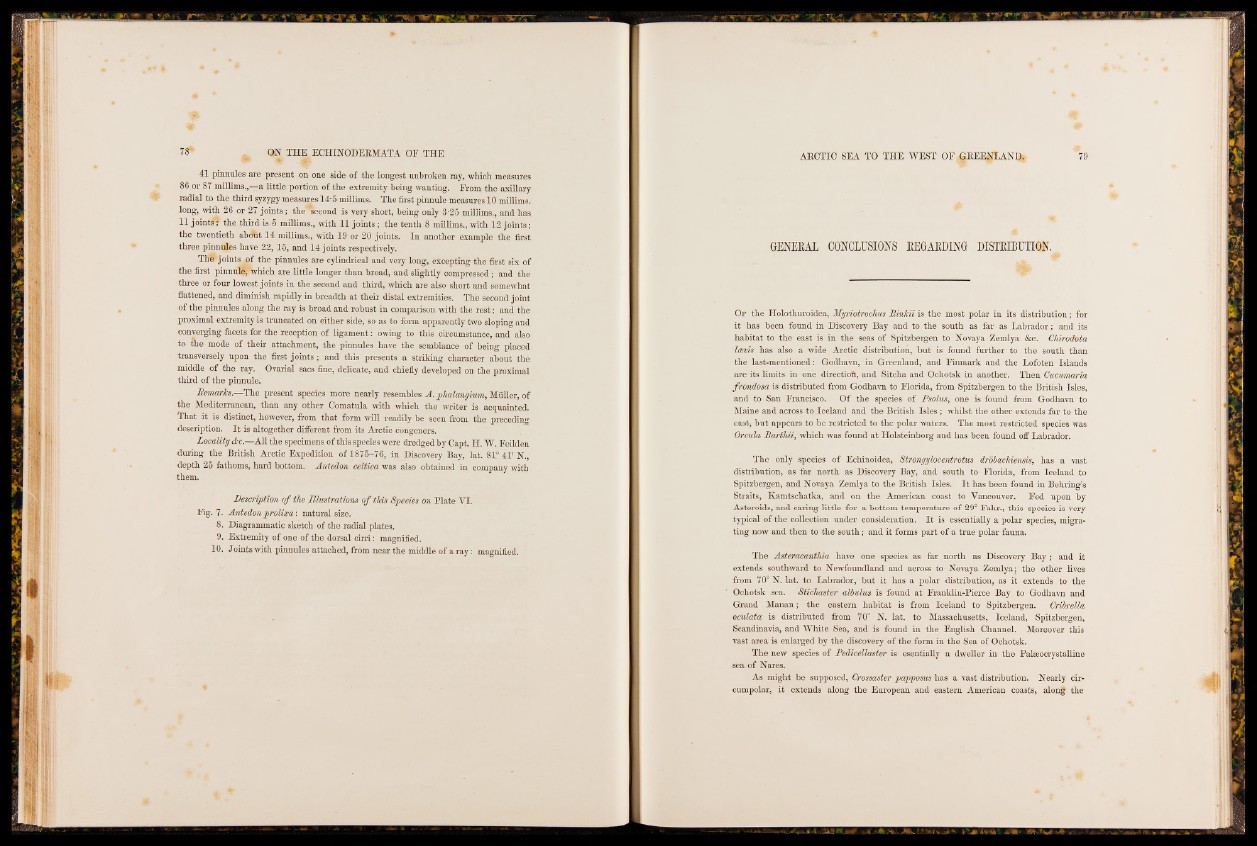
ON THE ECHINODERM ATA OF THE
i(r' -Mr
41 pinnules are present on one side of the longest unbroken ray, which measures
86 or 87 millims.,—a little portion of the extremity being wanting. From the axillary
radial to the third syzygy measures 14*5 millims. The first pinnule measures 10 millims.
long, with 26 or 27 joints; the ^second is very short, being only 3*25 millims., and has.
11 joints; the third is 5 millims., with 11 joints ; the tenth 8 millims., with 12 joints;
the twentieth abdftt 14 millims., with 19 or 20 joints. In another example the first
three pinnules have 22, 15, and 14 joints respectively.
Th#joints .of the pinnules are cylindrical and very long, excepting the first six of
the first pinnule, which are little longer than broad, and slightly compressed; and the
three or four lowest joints in the second.and third, which are also short and somewhat
flattened, and diminish rapidly in breadth at their distal extremities. The second joint
of the pinnules along the ray is broad and robust in comparison with the rest; and the
proximal extremity is truncated on either side, so as to form apparently two sloping and
converging facets for the reception of ligament: owing to this circumstance, and also
to me mode of their attachment, the pinnules have the semblance of being placed
transversely upon the first joints; and this presents a striking character about the
middle of the ray. Ovarial sacs fine, delicate, and chiefly developed on the proximal
third of the pinnule.
Remarks.—The present species more nearly resembles A. phalangium, Muller, of
the Mediterranean, than any other Comatula with which the writer is acquainted.
That it is distinct, however, from that form will readily be seen from the preceding
description. I t is altogether different from its Arctic congeners.
Locality &c.—All the specimens of this species were dredged by Capt. H. W. Feilden
during the British Arctic Expedition of 1875-76, in Discovery Bay, lat. 81° 41r N.,
depth 25 fathoms, hard bottom. Antedon celtica was also obtained in company with
them.
Description o f the Illustrations o f this Species on Plate VI.
Fig. 7. Antedon prolixa: natural size.
8. Diagrammatic sketch of the radial plates.
9. Extremity of one of the dorsal cirri: magnified.
10. Joints with pinnules attached, from near the middle of a ray: magnified.
GENERAL CONCLUSIONS REGARDING DISTRIBUTION.
Of the Holothuroidea, Myriotrochus RinJcii is the most polar in its distribution; for
it has been found in Discovery Bay and to the south as far as Labrador; and its
habitat to the east is in the seas of Spitzbergen to Novaya Zemlya &c. Chirodfota
Icevis has also a wide Arctic distribution, but is found further-to the south than
the last-mentioned: Godhavn, in Greenland, and Finmark and the Lofoten Islands
are its limits in one direction, and Sitcha and Ochotsk in another. Then Cucumaria
frondosa is distributed from Godhavn to Florida, from Spitzbergen to the British isles,
and to San Francisco. Of the species of Psolus, one is found from Godhavn to
Maine and across to Iceland and the British Isles ; whilst the other extends far to the
east, but appears to be restricted to the polar waters. The most restricted species was
Orcula Rarthii, which was found at Holsteinborg and has been found off Labrador.
The only species of Echinoidea, Strongylocentrotus drohachiensis, has a vast
distribution, as far north as Discovery Bay, and south to Florida, from Iceland to
Spitzbergen, and Novaya Zemlya to the British Isles. I t has been found in Behring’s
Straits, Kamtschatka, and on the American coast to Vancouver. Fed upon by
Asteroids, and caring little for a bottom temperature of 29° Fahr., this species is very
typical of the collection under consideration. I t is essentially a polar species, migrating
now and then to the south; and it forms part of a true polar fauna.
The Asteracanthia have one species as far north as Discovery Bay; and it
extends southward to Newfoundland and across to Novaya Zemlya; the other lives
from 70° N. lat. to Labrador,' but it has a polar distribution, as it extends to the
Ochotsk sea. Stichaster albulus is found at Franklin-Pierce Bay to Godhavn and
Grand Manan; the eastern habitat is from Iceland to Spitzbergen. Cribrella
oculata is distributed from 70° N. lat. to Massachusetts, Iceland, Spitzbergen,
Scandinavia, and White Sea, and is found in the English Channel. Moreover this
vast area' is enlarged by the discovery of the form in the Sea of Ochotsk.
The new species of Pedicellaster is esentially a dweller in the Palseocrystalline
sea of Nares.
As might be supposed, Crossaster papposus has a vast distribution. Nearly circumpolar,
it extends along the European and eastern American coasts, along the